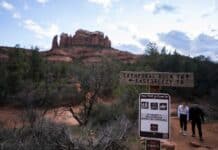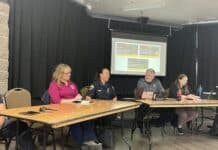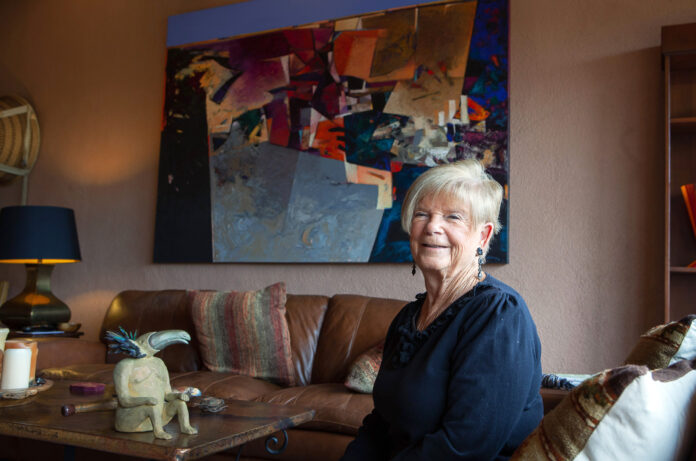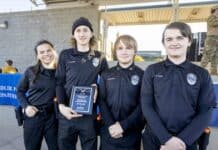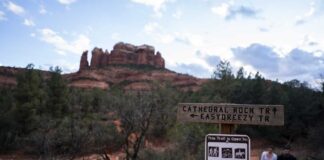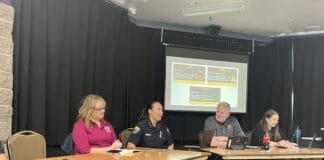Former Sedona art gallery owner Peggy Lanning has represented some of the most prolific American Indian artists of the Southwest — David Johns, Larry Yazzie, Baje Whitethorne Sr. and Tony Abeyta, to name a few.
In addition, the works of renowned contemporary artists hung on the walls of her galleries: Alfred Rogoway, who exhibited next to Jackson Pollack, Joan Miro, Willem de Kooning and Pablo Picasso; and Ted CoConis, who is in the Illustrators Hall of Fame and has painted iconic illustrations for film posters and Broadway shows; and Taos, N.M., artist Randall LaGro, whose poetic work invites the viewer to look within — to contemplate, wonder and imagine. Yet, when asked about her greatest accomplishment in life, Lanning responds that it is her three children: Bob, Michael and Kimber.
“I feel real proud of my three seeds that are planted. I always said if I don’t do anything else in this world, the thing I’m most proud of is the three honorable, good children that I put on this earth, you know,” Lanning said. “I mean that in every way. They’re different. Each one is different …. They’re still beautiful human beings, and all bring something to the world.”
Lanning’s oldest son Bob, 62, is an architect in Tucson. Michael Grant, 59, is a master jeweler. Kimber, 55, is an entrepreneur, musician and founder of Local First Arizona, a statewide nonprofit organization that assists underserved communities in rural areas.
Sitting on her patio in her art-filled home in West Sedona with Kimber by her side, 89-year-old Lanning reminisces about her life, which is as colorful as the artwork that once hung in her gallery. Kimber describes her mom as “a tortoise because she walks around with a hard shell, but she has a soft underbelly.”
“She instilled confidence in me and would yell after me saying,’ you just remember, Kimber, nobody can make you do anything.’ That was my kindergarten lesson,” Kimber said.
Sedona Galleries
Lanning has been known for her no-nonsense demeanor, tell-it-like-it-is attitude and an assertiveness that served her well over the years. She had an eye for art and the heart to make a difference — which did not go unnoticed among the artists she represented. Lanning owned two galleries in Sedona — one was her namesake, Lanning Gallery, which she opened in 1986, and the other, her first concept, the Turquoise Tortoise Gallery, which opened in 1971 in a flower shop in Glendale. She opened both of her galleries in the Hózhó Plaza located in the heart of Gallery Row on State Route 179.
Hózhó may be the most important word in the Navajo language. Often translated as “balance and beauty,” the concept of Hózhó carries with it an important emphasis on states of harmony — to be in Hózhó is to be at one with and a part of the world. The interconnectedness of Hózhó and Lanning’s relationship with American Indian artists was symbiotic. She had an uncanny sense of seeing their talents and abilities.
Lanning recalls the moment she met Abeyta, known for his artwork of New Mexico’s landscape, ancestral Navajo iconography and American Modernism.
“Tony Abeyta’s paintings are viewed not only with the eye, but also the soul,” Lanning said. “Tony was 17 when I met him. I sat in his booth at the Indian Market, but I recognized that he had talent. He let me sit in his booth — no one was there — we would talk.”
“He tells everybody he met me when he was 17. But he got to know me when he became an artist when he was 30,” Lanning stated.
Lanning Gallery was among the first to bring significant contemporary art to Sedona and helped to establish Sedona as an art destination. Her gallery featured works of art by world-renowned and cutting-edge emerging artists. Lanning exhibited original oil, acrylic, watercolor, ceramics, hand-carved furniture, contemporary sculpture, art glass and American Indian jewelry, including her son Michael’s turquoise jewelry.
The Turquoise Tortoise, located across a breezeway from Lanning Gallery showcased many of the top American Indian jewelers in the country. Lanning’s guiding principle and work ethic has always been to treat the artist with dignity and appraise their art fairly. The first time Lanning was approached by an American Indian artist to buy his jewelry, she asked how much he wanted for them.
“He replied, ‘Well, I was thinking $250,’” Lanning said. “And I said, ‘Well, I can’t give you a dime more than $300.’ And if you think that didn’t spread like wildfire amongst other artists, you’re wrong — the best of the artists came to me.”
Community Service
“I was surprised at how one thing led to another,” Lanning said. “I’ve always tried to give back to the community. I’ve never felt like the community owed me anything. I always felt like I owed the community because it is a great community. I would get myself involved in different things.”
Lanning helped to raise money for children who couldn’t attend camp in Sedona. She spoke to teachers and had the children make pottery, which she then displayed in her gallery on pedestals — just like the masters — and sold them for $20 to $40. The money raised went back to the school to pay for the camp.
“The children were so proud,” Lanning said. “They had to learn to speak to adults and show their work. They didn’t just bring their work, they had to stand by it, show it and tell people about it when they were looking to buy.
“All the money went into a kitty and then all the kids got to go to camp. So, that was one of the first things I did with the schools.”
Gulf Coast Childhood
Lanning was raised on the Gulf Coast in a little town of Long Beach, Miss., 67 miles east of New Orleans. She said her mother trained her as an entrepreneur from the get-go.
“My mother trained me at a very young age about how to make money and earn your keep,” Lanning said. “She was the only female Realtor and owner of the business in the 1930s in Mississippi. And I remember as a child sitting at her desk. She had me answering the phone at a very young age — but you learn a lot that way.”
At age of 10 or 12, Lanning said she would go door to door asking people if they were thinking of putting their house on the market.
“Of course, this was cold calling. I didn’t know that,” Lanning said. “And they said, ‘No, honey, we’re not going to sell ours.’ But the husband would say, ‘Oh, but Maude, you know, the Harrises were talking about selling their house.’ So, I got the lead.”
Lanning explained that she learned the best of both worlds from her parents “My father was more giving than my mother,” Lanning said of her father, Walter.
“I can remember as a child, the phone would ring in the middle of the night and somebody would be in trouble or they’d be in jail. And they would call Walter to help them. And then my father would go and get dressed and work with the law to see if he could get them out and take him home.”
“I learned a lot of that from my dad,” Lanning said. “And my mother was more of an entrepreneur.”
The tenacity she exuded as a child was instilled in her children. Kimber describes her mom as being able to overcome the odds, and she appreciated her toughness, grit and entrepreneurship that led to this moment and also her level of compassion. Kimber grew up in Glendale, but visited Sedona as a child. Her father was a fighter pilot stationed at Luke Air Force Base.
“My father did three tours of duty in Vietnam,” Kimber said. “Mom was always adamant about taking us out to do things when he was gone because she didn’t want us to be the only kids sitting at home whose dads weren’t around, especially on Sundays. So often, she brought us up to Sedona and we used to stay at Briar Patch Inn or we’d go to the Rainbow Trout Farm. She brought us up here long before she thought about opening that gallery.”
Final Exhibition
When Lanning was about to retire in 2017, she wanted to do one more exhibition as a grand finale — not in her gallery but in the Booth Museum of Western Art, in Cartersville, Ga. She approached Seth Hopkins, executive director of the museum, to do a show featuring six of the best living Navajo master artists: Abeyta, Johns, Yazzie, Whitethorne, Shonto Begay and Emmi Whitehorse. Lanning was asked to be a guest curator.
On May 16, 2019, Lanning, Kimber and her long-time business associate and gallery director Isabelle Cozart put together the exhibition. The art included highlights of the rich cultural and spiritual Navajo traditions and the messages conveyed by each artist in their styles. Many of the artists have been with Lanning for 40 plus years — including Johns and Abeyta.
“It was beautiful. I felt very proud. And I thought ‘what a wonderful way to end my career to have a show like this,’” Lanning said. “And the show was not about me. The show was about Navajo artists. And they gave them a wonderful theater to speak and show their work. And they stood by their work and talked to everyone about it. And everybody was very interested.”
“They said at the Booth Museum, that it was the biggest turnout they’ve ever had for an opening reception,” Kimber said. “It was packed.”
When asked if she misses her galleries, Lanning responds with a gleam in her eye, “Oh, yeah, sure I do, sometimes. But I also realized at the end, that I was missing a beat. You know, I mean, I was 85. And you’re bound to miss a beat every now and then when you get that age. It’s a lot of responsibility. A lot of employees, 40 artists. So, I miss it sometimes.”
Lanning’s philosophy has always been if you do right by the universe, the universe will do right by you.
“It’s just something that comes naturally. I never miss an opportunity to look a little further and see if I think I can make a difference. And if I think I can, I will. I’m not sad about anything that I didn’t do. I would have to say I did everything that I wanted to do — and then some. But I wouldn’t say that there were things that I wish I could do. I would be too busy trying to find a way to do it.”


